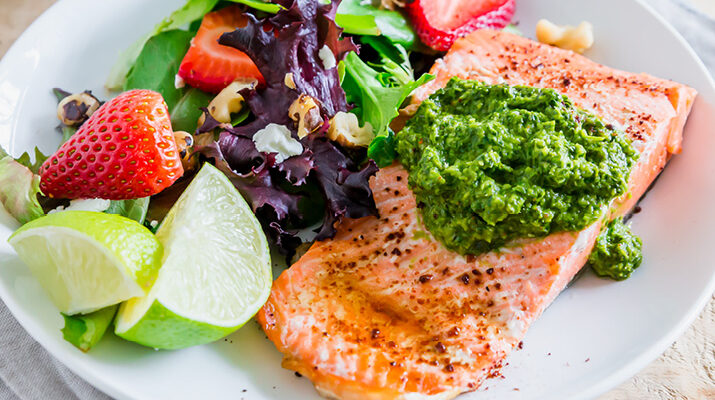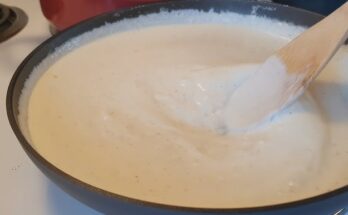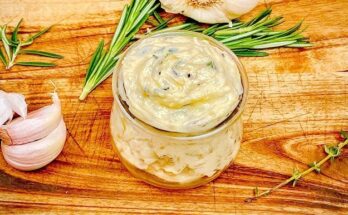Arctic Char Recipe: If you’ve never tried cooking Arctic Char before, you’re in for a real treat. This flavorful fish, often described as a delicious mix between salmon and trout, is incredibly versatile, quick to prepare, and packs a nutritious punch. Whether you’re a kitchen newbie or an experienced home cook, learning how to cook Arctic Char is one skill worth mastering.
The beauty of Arctic Char lies in its mild, slightly sweet flavor and tender, flaky texture. It’s less oily than salmon but richer than trout—basically, the best of both worlds. Plus, it’s packed with Omega-3 fatty acids, making it a heart-healthy dinner option that doesn’t compromise on taste.
In this step-by-step guide, we’ll walk you through everything you need to know—from selecting the best fillets to marinating, cooking, and serving your Arctic Char like a pro. Ready to get started? Let’s dive in.
Ingredients You’ll Need
Before you even turn on the stove, let’s gather everything you’ll need. Here’s a complete list of ingredients for a basic but flavorful Arctic Char dish, along with some optional add-ons if you want to elevate the flavor.
Basic Ingredients:
- 2 Arctic Char fillets (6-8 oz each, skin-on preferred)
- 2 tablespoons olive oil
- 1 lemon (zest and juice)
- 2 garlic cloves (minced)
- Salt and freshly ground black pepper to taste
- Fresh dill or parsley for garnish
Optional Add-Ons:
- 1 tablespoon butter (for a richer flavor)
- 1 teaspoon Dijon mustard (for tanginess)
- Crushed red pepper flakes (for heat)
- Capers or olives (for a Mediterranean twist)
- Fresh herbs: thyme, rosemary, or basil
For Marinade or Sauce:
- 2 tablespoons Greek yogurt
- 1 tablespoon honey or maple syrup
- 1 teaspoon lemon zest
- 1 tablespoon chopped dill
Nutritional Snapshot:
- High in protein (around 30g per serving)
- Rich in Omega-3 fatty acids
- Contains Vitamin B12, D, and selenium
Everything on this list is easy to find at your local grocery store or fish market. And feel free to improvise—cooking should be fun, not rigid. The beauty of Arctic Char is that it adapts well to a variety of flavors and styles.
Choosing the Right Arctic Char
Quality matters, especially when it comes to fish. You want Arctic Char that’s fresh, firm, and handled properly from sea to store. So, what should you look out for?
Wild-Caught vs. Farm-Raised: Arctic Char is often farm-raised in sustainable environments, making it a responsible seafood choice. Wild-caught is less common but can offer a slightly more robust flavor. Either is fine, just make sure it’s responsibly sourced.
Freshness Indicators:
- Smell: Should have a clean, ocean-like scent—not fishy.
- Color: Should be pink to light red, not dull or gray.
- Texture: Flesh should be firm, not mushy.
- Skin: If buying skin-on, it should be shiny and moist.
Pro Tip: If you’re buying from a fish counter, don’t hesitate to ask when it arrived. The fresher, the better.
Buying frozen? Totally fine! Just make sure it’s vacuum-sealed and doesn’t have signs of freezer burn (like white spots or dry edges).
Tools and Equipment Needed
Cooking a great meal starts with having the right tools. Don’t worry—you don’t need a professional kitchen. Most of what you need is probably already in your cabinets.
Essentials:
- Non-stick or cast iron skillet (for pan-searing)
- Baking sheet with parchment paper (for baking)
- Grill and tongs (for outdoor grilling)
- Mixing bowl (for marinades)
- Sharp chef’s knife
- Cutting board
- Fish spatula (thin and flexible)
Optional but Helpful:
- Food thermometer (to avoid overcooking)
- Zester or microplane (for lemon zest)
- Basting brush (for applying glaze)
Setting up your kitchen in advance avoids chaos later. Prep your tools, lay out your ingredients, and set yourself up for a smooth cooking session.
Prepping Your Ingredients
Let’s talk prep. A little effort here goes a long way toward a stress-free, flavorful final dish.
Step 1: Clean the Fish
If your Arctic Char wasn’t pre-cleaned, rinse it gently under cold water and pat dry with paper towels. Always work with dry fish—it helps with crisping the skin.
Step 2: Portioning
If cooking for more than two, you can cut a large fillet into 6-8 oz portions. Always slice against the grain.
Step 3: Prepping Add-Ons
- Mince your garlic
- Zest your lemon
- Chop herbs
- Cut your side veggies (broccoli, asparagus, carrots, etc.)
Step 4: Make Your Marinade or Rub
Combine olive oil, lemon juice, minced garlic, herbs, and a pinch of salt and pepper. Coat the fish generously and let it sit (more on that below).
Take your time here. Organized prep is the secret sauce of all great cooks.
Marinating for Maximum Flavor
Marinating is where the magic happens. While Arctic Char already has a beautifully delicate flavor, a well-balanced marinade can take it from “good” to “you should open a restaurant.” You don’t need anything fancy—just a handful of ingredients and a bit of patience.
Simple Marinade Recipe:
Here’s a basic go-to marinade that enhances the natural flavor of Arctic Char without overpowering it.
- 2 tablespoons olive oil
- Juice of 1 lemon
- 1 teaspoon lemon zest
- 2 garlic cloves, minced
- 1 tablespoon chopped fresh dill
- Salt and freshly ground pepper
Mix everything in a bowl, then pour it over the fillets in a shallow dish. Let the fish sit for 15–30 minutes at room temperature, or up to 1 hour in the fridge. Avoid marinating for too long—fish is delicate and can start to “cook” in acid (like ceviche) if left too long.
Why Marinating Matters:
- Enhances flavor without masking the fish
- Tenderizes the flesh
- Adds moisture, which helps prevent drying out during cooking
Storage Tips:
If marinating in the fridge, cover the dish with plastic wrap. Always bring the fish back to room temperature before cooking to ensure even doneness.
So go ahead—let your Char soak up all that herby, citrusy goodness while you prep your sides or fire up the grill.
Cooking Methods for Arctic Char
Arctic Char is one of the most flexible fish when it comes to cooking techniques. Whether you’re using a skillet, oven, or grill, it holds up beautifully and cooks fast. Here’s a breakdown of the top three methods, including when and why you might choose each one.
1. Pan-Searing (For Crispy Skin Lovers)
Quick, flavorful, and gives you that satisfying crispy skin. Great for a weeknight dinner.
2. Oven-Baking (Foolproof and Even Cooking)
Ideal if you want to cook other dishes simultaneously. Perfect for beginners.
3. Grilling (For a Smoky Touch)
Great for summer days or outdoor cooking. Adds a wonderful char and depth of flavor.
Each method is easy, fast (we’re talking 10–15 minutes max), and delivers delicious results. Let’s break them down step-by-step.
Pan-Seared Arctic Char Recipe
Pan-searing gives you a crisp, golden-brown skin while keeping the flesh tender and juicy. This method is quick and hard to mess up if you follow a few simple tips.
Step-by-Step Instructions:
- Preheat the Pan: Use a heavy-bottomed skillet (cast iron works great). Heat it over medium-high for 2–3 minutes until hot.
- Prep the Fish: Pat the fillets completely dry. Moisture = soggy skin. Season both sides with salt and pepper.
- Add Oil: Pour 1–2 tablespoons of olive oil into the hot pan and swirl to coat.
- Skin-Side Down First: Gently lay the fish in the pan, skin-side down. Don’t move it for 4–5 minutes.
- Press Gently: Use a spatula to press the fish down slightly to prevent curling.
- Flip Once: When the skin is crisp and the color changes halfway up the side, flip it gently.
- Cook Second Side: Cook for another 2–3 minutes. You’re done when the center is opaque and flakes easily.
Pro Tips:
- Don’t overcrowd the pan—give your fish room to breathe.
- If the skin sticks, it’s not ready to flip. Let it cook a bit longer.
- Finish with a squeeze of lemon and fresh dill.
What to Serve With It:
Roasted potatoes, asparagus, or a crisp fennel salad pair beautifully with pan-seared Char.
Oven-Baked Arctic Char Recipe
If you’re looking for a stress-free method that delivers evenly cooked, tender fish every time, baking is your go-to. It’s also perfect when you’re cooking for a group.
Step-by-Step Instructions:
- Preheat the Oven: Set to 400°F (200°C). Line a baking sheet with parchment paper or foil.
- Season the Fish: Place fillets skin-side down. Drizzle with olive oil, lemon juice, herbs, and seasonings.
- Add Veggies (Optional): Toss in sliced zucchini, cherry tomatoes, or asparagus for a one-pan meal.
- Bake Time: Bake for 10–12 minutes, depending on the thickness. The fish should flake easily with a fork.
- Optional Glaze: Halfway through baking, brush with a honey-lemon glaze for extra shine and flavor.
Pro Tips:
- Don’t overbake! Start checking around the 9-minute mark.
- Use a thermometer: Internal temp should be 130°F (54°C) at the thickest part.
- Let it rest for 2 minutes before serving.
Serving Ideas:
Pair with couscous, herbed rice, or a quinoa salad with cucumbers and mint.
Grilled Arctic Char Recipe
Nothing beats the smoky flavor of grilled fish. Whether on a charcoal or gas grill, Arctic Char takes beautifully to high-heat, direct cooking.
Step-by-Step Instructions:
- Preheat the Grill: Clean and oil the grates well. Preheat to medium-high.
- Oil the Fish: Rub both sides with olive oil and your seasoning mix. Optional: add lemon slices on top.
- Grill Skin-Side Down: Place the fish directly on the grill, skin-side down. Close the lid and cook for 5–6 minutes.
- Flip Gently: Flip using a wide spatula and grill for another 3–4 minutes until just opaque.
- Rest and Serve: Remove from the grill and rest for 2 minutes. Garnish with fresh herbs.
Tips for Grilling Success:
- Make sure the grates are HOT and OILED to prevent sticking.
- Use a grill basket if you’re nervous about flipping.
- Add soaked cedar planks for extra smoky flavor.
Great with: Grilled corn, orzo salad, or charred bell peppers.
Making a Flavorful Sauce or Glaze
Let’s be real—sauces are the secret weapon that can elevate any Arctic Char dish from “nice” to “OMG, what is this deliciousness?” The right sauce complements the fish’s natural richness without overpowering it. Whether you’re in the mood for buttery, zesty, creamy, or sweet, there’s a flavor profile here for you.
1. Classic Lemon-Butter Sauce
This one’s a fan favorite. It’s rich, bright, and ridiculously easy to make.
Ingredients:
- 2 tablespoons unsalted butter
- Juice of ½ lemon
- 1 garlic clove, minced
- Salt and pepper to taste
- 1 teaspoon chopped parsley or dill
How to Make It:
- In a small saucepan, melt the butter over low heat.
- Add the garlic and sauté for 30 seconds until fragrant.
- Add lemon juice, stir in the herbs, and season with salt and pepper.
- Drizzle over freshly cooked Arctic Char.
Pro Tip: Add a touch of white wine or a splash of cream to make it even more indulgent.
2. Dill & Garlic Yogurt Glaze
If you’re craving something light and creamy with a herby kick, this glaze is perfect.
Ingredients:
- ½ cup Greek yogurt
- 1 tablespoon fresh dill, chopped
- 1 garlic clove, finely grated
- 1 teaspoon lemon zest
- Salt and pepper
How to Make It:
- Mix all ingredients in a bowl.
- Let sit for 10–15 minutes to allow the flavors to develop.
- Serve chilled or at room temperature on the side or spread directly on top of the fish before serving.
3. Honey Mustard Glaze (For a Sweet-Savory Twist)
If you like a bit of tang and sweetness, this one’s a winner.
Ingredients:
- 1 tablespoon Dijon mustard
- 1 tablespoon honey
- 1 teaspoon lemon juice
- Pinch of paprika or cayenne (optional)
How to Make It:
- Mix all ingredients in a bowl.
- Brush on the Arctic Char during the last 2–3 minutes of cooking.
- You’ll get a glossy finish and a flavor-packed bite.
The Bottom Line: Sauces are your playground. Keep it fresh, keep it flavorful, and feel free to experiment.
Best Side Dishes to Serve With Arctic Char
Your Arctic Char might be the star of the plate, but let’s not forget the supporting cast. A perfectly cooked piece of fish deserves sides that complement its taste and texture. Here are some tasty options to consider.
Vegetable Sides:
- Roasted Asparagus with lemon zest and shaved Parmesan
- Sautéed Spinach or Kale with garlic and olive oil
- Charred Brussels Sprouts with balsamic drizzle
- Grilled Zucchini or Eggplant for a Mediterranean vibe
Grains & Starches:
- Lemon-Herb Quinoa
- Wild Rice Pilaf with cranberries and toasted almonds
- Creamy Mashed Potatoes or garlic mashed cauliflower
- Couscous with Feta and Cherry Tomatoes
Fresh Salads:
- Arugula Salad with pear, walnuts, and goat cheese
- Greek Salad with cucumbers, olives, and red onions
- Beet and Citrus Salad with mint and pistachios
Pro Tip: Use ingredients that mirror the seasoning of your fish for a more cohesive meal. If you’re doing a lemon-herb glaze on the fish, try a lemon vinaigrette on your greens too.
A good rule of thumb? One cooked veg, one grain, and one raw/fresh element make a well-rounded plate.
Plating and Presentation Tips
They say we eat with our eyes first—and when it comes to plating your Arctic Char, it’s 100% true. Even if you’re just making a Tuesday night dinner for yourself, a little effort goes a long way.
Tips for Plating Like a Pro:
- Use a White Plate: Let the colors of your food pop.
- Highlight the Fish: Place the fillet in the center or slightly off-center.
- Add Color Contrast: Think vibrant veggies or herbs for visual interest.
- Sauce Strategically: Drizzle it artistically around or beneath the fish, not just on top.
- Garnish Last: Add fresh herbs, lemon wedges, or edible flowers to finish the dish.
Example Plate Layout:
- Bottom Layer: A bed of lemon couscous or rice.
- Main Feature: Place your Arctic Char fillet on top, skin side up for crunch.
- Side Dish: Roasted asparagus fanned out to the side.
- Finishing Touches: Drizzle sauce, sprinkle herbs, add a slice of charred lemon.
Make it look Instagram-worthy—even if it’s just for your own satisfaction.
Storing Leftovers Properly
Cooked Arctic Char can absolutely be enjoyed the next day—if you store it the right way.
In the Fridge:
- Storage Time: 2–3 days max.
- How: Store in an airtight container. Let it cool completely before sealing to avoid condensation.
In the Freezer:
- Yes, you can freeze it!
- Wrap tightly in plastic wrap and place inside a freezer-safe bag or container.
- Label it with the date.
- Good for up to 2 months.
Reheating Tips:
- Avoid the microwave—it can dry out the fish.
- Best method: Reheat gently in a covered skillet with a splash of water or broth.
- Or pop it in a 300°F oven for 10–12 minutes until just warmed through.
Pro Tip: Cold Arctic Char makes an excellent topping for salads, grain bowls, or even breakfast toast with avocado and a poached egg.
Health Benefits of Eating Arctic Char
Not only is Arctic Char delicious, but it’s also a nutritional powerhouse that’s good for your body and brain. Let’s break down why this fish deserves a regular spot on your menu.
High in Omega-3 Fatty Acids:
These essential fats help reduce inflammation, support heart health, and improve brain function. Arctic Char rivals even salmon in its Omega-3 content, making it a top-tier choice for heart-conscious eaters.
Lean Protein Source:
Each 6-ounce serving packs about 28–30 grams of protein. That’s muscle-building fuel without the heavy calories or fat found in red meat.
Rich in Vitamins and Minerals:
- Vitamin D – crucial for bone health and immune function
- Vitamin B12 – supports nerve health and energy production
- Selenium – a powerful antioxidant
Low Mercury Levels:
Compared to larger fish like tuna or swordfish, Arctic Char has significantly lower mercury, making it safer for frequent consumption—even for pregnant women and children.
Sustainable Choice:
Most Arctic Char on the market is responsibly farmed in low-impact systems, making it a more environmentally friendly seafood option.
In short, it’s a win for your taste buds and your health.
FAQs about Arctic Char Recipe
1. What does Arctic Char taste like?
Arctic Char has a delicate, slightly sweet flavor—like a cross between salmon and trout. It’s rich but not overpowering, making it ideal for a variety of seasonings and sauces.
2. Can I substitute Arctic Char with another fish?
Yes! Salmon, trout, or steelhead are great substitutes. Just adjust the cooking time slightly based on the thickness of the fillets.
3. How do I prevent the skin from sticking to the pan?
Make sure your pan is hot and oiled before adding the fish. Also, pat the fillet dry and don’t flip too early—let the skin crisp and release naturally.
4. Is Arctic Char sustainable?
Absolutely. Most Arctic Char is farmed using sustainable methods with minimal environmental impact, making it a responsible seafood choice.
5. Can I cook Arctic Char from frozen?
Yes, though it’s best to thaw first. If cooking from frozen, increase the cooking time and avoid pan-searing—baking is more reliable.
Conclusion
There you have it—a complete, step-by-step guide to mastering Arctic Char in your home kitchen. From picking the perfect fillet to choosing the best cooking method, whipping up a killer sauce, and plating it like a chef, you now have all the tools to turn this versatile fish into a crowd-pleasing meal.
Whether you prefer it pan-seared with crispy skin, oven-baked with lemony herbs, or grilled to smoky perfection, Arctic Char is one of those rare ingredients that’s simple, healthy, and impressive all at once.
So next time you’re at the fish counter or scrolling for weeknight dinner inspiration, remember this guide. Go ahead—get cooking, get creative, and let your taste buds do a happy dance.



